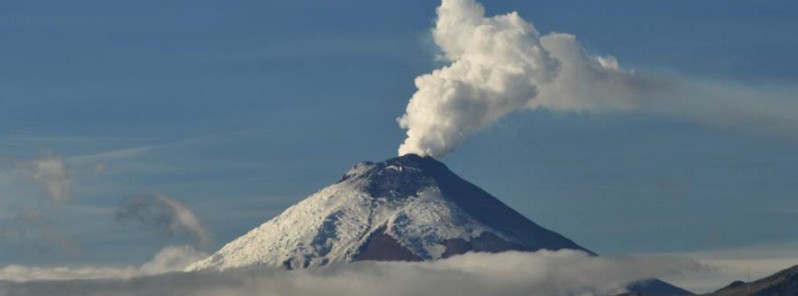Scientists improve forecast of increasing hazard on Cotopaxi volcano

An international team of scientists showed an increasing volcanic danger on Cotopaxi volcano in Ecuador using a powerful technique known as Interferometric Synthetic Aperture Radar (InSAR).
The Andes region in which Cotopaxi volcano is located is known to contain some of the world's most serious volcanic hazard. A mid- to large-size eruption has the potential to instantaneously melt the summit glacier, resulting in devastating mudflows that would intersect with several towns in the Inter-Andean valley—one of the most densely populated regions of Ecuador.
In August 2015, after four months of increasing seismic tremors and gas emissions, Cotopaxi began to erupt.
"Using the InSAR technique, we were able to detect three centimeters of ground inflation along one flank of the volcano during the pre-eruption period," said Anieri Morales-Rivera, a UM Rosenstiel School graduate student and lead author of the study.
Ground inflation occurs when new magma moves closer to the surface.
The results of the study are supported by ground-based GPS instruments operated around the volcano by the IGEPN, the Ecuadorian agency responsible for monitoring Cotopaxi.
"From our instruments, we knew there was serious activity within Cotopaxi," said Patricia Mothes, a chief volcanologist at the IGEPN and co-author of the study. “The satellite data allowed us to pinpoint where the uplift took place, which in turn helped us better understand how the magma ascended prior to the eruption."
ASI begun acquiring the SAR imagery in this region half a year before Cotopaxi’s unrest started. Although ASI did not know the eruption was imminent, they were aware of the high risks related to Cotopaxi because of their involvement with Geohazard Supersites and Natural Laboratories (GSNL), a recently formed international initiative between space agencies, volcano monitoring agencies and researchers. The objective of the initiative is to better utilize advanced satellite resources for the monitoring of geological activity and to mitigate the development of a crisis.
"Our work would not have been possible without the many images that ASI had acquired," said Falk Amelung, a UM Rosenstiel School professor in the Department of Marine Geosciences and a co-author of the study.
Amelung also noted that the accuracy of the InSAR technique improves with the increased availability of SAR images.
"This satellite data will play an increasingly important role for the monitoring and the study of Ecuadorian volcanoes, said Mothes. "Since it is not possible for us to place dense measurement networks on all potentially active sites in Ecuador —since there are about 40 potentially active volcanoes."
Future eruptions of the Cotopaxi volcano are expected to be preceded by similar or greater ground inflation. With the GSNL framework in place, Cotopaxi continues to be monitored from space, making it easier to prepare for the next eruption.
Source: RSMAS – University of Miami
Reference:
"Ground deformation before the 2015 eruptions of Cotopaxi volcano detected by InSAR" – Aneri M. Morales Rivera et al. – Geophysical Research Letters – July 2017 – DOI: 10.1002/2017GL073720
Featured image: Cotopaxi volcano, Ecuador

Commenting rules and guidelines
We value the thoughts and opinions of our readers and welcome healthy discussions on our website. In order to maintain a respectful and positive community, we ask that all commenters follow these rules.